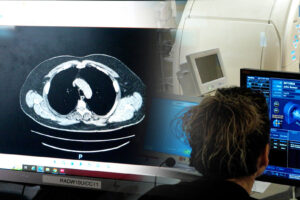5 Healthcare Tech Trends Worth Keeping an Eye On
Published 7/11/20 on Tech News
The healthcare industry is experiencing rapid shifts. Some of this is a result of the current pandemic, but a lot of this evolution was happening even prior to the COVID-19 outbreak. Understanding and embracing the introduction of new technology into the market will be very important to healthcare professionals and patients alike.
Here are some of the trends worth tracking:
1. Telemedicine
If you want to discuss major evolution and change within the U.S. healthcare system, look no further than telemedicine (also known as telehealth).
In a country as large and disseminate as the U.S., telemedicine – or the practice of health practitioners meeting virtually with patients – is highly attractive and mutually beneficial. This is especially true from a cost perspective. Telemedicine lowers the price of care for both patients and doctors by reducing many of the physical barriers that take time and deplete resources. It’s also a much more efficient way of meeting – eliminating the commuting aspect and preventing wasted time in waiting rooms and lobbies.
According to 1 recent report, the world wide telemedicine market is likely to expand from its current size of $45 billion to $175.5 billion by when 2026. That represents a robust compound annual growth rate of 19.3 percent. The growth drivers will include:
- Rising cases of COVID-19 and anticipation of similar future events
- Increased prevalence of chronic diseases in an aging population
- Growing quantity of smartphone users and internet-connected households
- Major technological advances in relation to cell phones and internet (like 5G)
- Serious requirement for cost-savings in an costly healthcare environment
- Long waiting times in hospitals for disease treatment
- Advantageous government initiatives
There will also be some challenges and risk factors dancing. In the United States, the biggest concern has to do with cyber security and privacy – particularly when it comes to sensitive and painful patient data (which is carefully regulated under HIPAA rules).
Regulatory dilemmas and compliance requirements – both on a macro scale (government) and a micro scale (healthcare industry) – will generate issues dancing. But when the red tape is handled, growth and adoption will skyrocket.
2. The Internet of Medical Things
According to Deloitte, medical technology organizations manufacture a lot more than 500,000 different types of medical devices. This includes wearable external medical devices (like insulin pumps and skin patches), implanted devices (such as pacemakers), and stationary medical devices (like scanning machines). And almost every interaction a patient has with a healthcare provider or system involves the use of one of these brilliant devices or pieces of equipment.
At the same time frame, the healthcare industry is now increasingly connected (in an electronic digital sense). Cloud computing, big data, wireless technology, and Software-as-a-Service (SaaS) are all working together to transmit, store, and interpret data.
What happens when you combine telemedicine with the internet of things (IoT)? Well, you obtain the Internet of Medical Things (IoMT), of course!
“The IoMT brings together the digital and physical worlds to improve the speed and accuracy of diagnosis and treatments, and monitor and modify patient behaviour and health status in real time,” Deloitte explains. “It also improves health care organizations’ operational productivity and effectiveness by streamlining clinical processes, information and work flows.”
The IoMT market was valued at roughly $41.2 billion in 2017 and is expected to balloon to $158.1 billion by 2022. (The connected medical devices portion of the marketplace – which can be responsible for diagnosing, monitoring, and treating patients – will account for $52.2 billion of the marketplace.)
Most healthcare companies in the United States are already using IoMT technology in some capacity. The growth will occur from increased use and greater reliance on the unit and platforms over the next 24 to 30 months.
3. Low-Level Light Therapy
Now that we’ve addressed a few the major sweeping trends in the industry, let’s explore a few of the smaller healthcare tech trends that are occurring within specific niches and industries.
Low-level light therapy (LLLT) is the first micro trend we want to discuss. It’s perhaps one of the most promising developments in the premature baldness space (which impacts tens of countless men and women on an annual basis).
LLLT, which can be backed by years of research and many authoritative scientific tests, can be administered in a number of ways. One of the very most common and convenient practices is with the use of a laser hair cap (which looks a lot like a typical baseball cap).
LLLT caps work by improving cellular respiration and stimulating hair follicle growth with the use of safe low-level lasers which can be known to produce thicker and healthier hair. Until recently, the technology could only be administered in a physician’s office. But with advances in complete safety and the practicality of new laser caps, folks are now in a position to perform regular sessions (usually 30 minutes) from the comfort of the own domiciles.
Considering that two-thirds of American men will experience a point of baldness by age 35 (and 85 % by age 50), health-tech like LLLT is extremely important and relevant.
4. Wearable Health Devices
There’s a huge surge in the number of patients who want to manage to monitor their particular health on a day-to-day basis. This swelling rise is in conjunction with an increased familiarity and willingness to utilize mobile devices and technology that track information and data. The result is rampant demand for wearable health devices, which health-tech organizations are using as a license to innovate and manufacture new lines of products and services.
The wearable health market has exploded significantly throughout the last couple of years and is a welcome trend for patients, health practitioners, insurers, and everyone else among. Common devices include wearable fitness trackers, smart health watches, wearable blood pressure monitors, wearable ECG monitors, as well as biosensors.
This latter product category is especially interesting. It includes things like the self-adhesive trackers – like the Philips wearable biosensor.
“Research from Augusta University Medical Center showed that this wearable device registered an 89% reduction in patient deterioration into preventable cardiac or respiratory arrest,” BusinessInsider mentions. “This demonstrates the ability wearables have to improve patient outcomes and possibly reduce staff workload.”
According to 1 industry forecast, the biosensor market is expected to grow from $21.2 billion in 2019 to $31.5 billion by 2024. That amounts to a compound annual growth rate of 8.3 %.
5. Augmented Reality
Currently valued around $850 million, the global market for virtual reality (VR) and augmented reality (AR) in the healthcare space is likely to scale as much as somewhere north of $5.1 billion by as soon as 2025.
While AR can be used in just about any number of ways, one of the primary healthcare applications will occur in operating rooms and doctor training/education.
Depth perception is something that’s very challenging in certain procedures, yet paramount to achieving successful outcomes. When arteries and nerves are in close proximity one to the other, being able to have precise and accurate assessment of depth becomes critical. New technology is addressing this.
The Maryland Blended Reality Center is amongst the leaders behind this charge. They’re currently in the development stages of an AR application that overlays computer pictures over the doctor’s view of the real world to simply help guide catheters into patients’ brains to alleviate pressure after injuries. With the use of this technology, health practitioners can perform procedures like this within 0.5 millimeters of accuracy.
As the underlying technology improves, healthcare experts anticipate seeing a lot more revolutionary technology emerge. The next several years will undoubtedly be incredibly very important to innovation in this sector of the health-tech market.
A Brave New Medical World
The innovation that’s happening in and around the healthcare industry is both unprecedented and astonishing. While this is an industry that’s always been seen as an innovation, the speed of iteration is blistering. As a medical practioner, techpreneur, or trendsetter, they are exciting times.
Stay tuned in – as always, don’t be afraid to pivot, shift, or evolve along with the technology.
Frank Landman
Frank is really a freelance journalist who did in various editorial capacities for over 10 years. He covers trends in technology as they relate with business.



